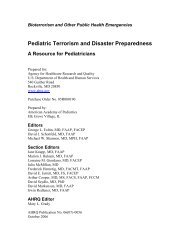H1N1 COUNTERMEASURES STRATEGY AND ... - PHE Home
H1N1 COUNTERMEASURES STRATEGY AND ... - PHE Home
H1N1 COUNTERMEASURES STRATEGY AND ... - PHE Home
Create successful ePaper yourself
Turn your PDF publications into a flip-book with our unique Google optimized e-Paper software.
NBSB Pandemic Influenza Working Group<br />
Detailed Report<br />
Network provides additional virus surveillance. CAPT Fiore described additional<br />
morbidity surveillance efforts through these programs to identify ILI and SARI with<br />
laboratory confirmation. Population-based surveillance and community surveys provide<br />
still more information.<br />
The WHO Global Surveillance Global Influenza Surveillance Network is likely to be a<br />
key source of information in the next few months, said CAPT Fiore. It involves four<br />
WHO Collaborating Centres and the CDC in surveillance that includes Australia and<br />
Japan. The Centers collect specimens, isolate and characterize the virus, then ship the<br />
samples to other laboratories for more sensitive testing. CAPT Fiore said relatively few<br />
participating countries (25 of 126) are located in the Southern Hemisphere, but he expects<br />
to see both seasonal and <strong>H1N1</strong> virus circulation in the tropical areas of the Northern<br />
Hemisphere.<br />
A fair amount of CDC staff is stationed in areas in which <strong>H1N1</strong> circulation is anticipated.<br />
Information is coming in from the Southern Hemisphere. In Australia, 1,400 cases of<br />
influenza have been tested, of which about one third represent novel <strong>H1N1</strong>. The rest are<br />
seasonal influenza, mostly H3N2. Surveillance in Central and South America have been<br />
reinvigorated with funding and staff, said CAPT Fiore. Peru has established outpatient<br />
surveillance similar to ILINet but on a smaller scale, with a focus on severe disease in<br />
Lima. Field staff in South America can provide weekly or biweekly information that<br />
points to unusual clusters of disease.<br />
CAPT Fiore summarized what we know so far in those areas where <strong>H1N1</strong> is circulating:<br />
<br />
<br />
<br />
<br />
<br />
<br />
Will the pandemic virus continue to circulate? Yes.<br />
Will it cocirculate with other influenza viruses? Preliminarily, yes.<br />
Is the virus changing? Viral surveillance plans are in place to evaluate this<br />
question.<br />
Are epidemiologic parameters changing (e.g., attack rate, incubation period)? It<br />
will be difficult to obtain representative data in most countries, but ongoing<br />
outbreaks in the United States will also provide data.<br />
Are clinical manifestations changing (e.g., severity, secondary infections)? It will<br />
be difficult to determine given different health care parameters, but getting viruses<br />
from unusual or severe cases is feasible.<br />
Are community mitigation interventions working? It may be possible to assess<br />
this question in several countries (e.g., from Chile’s school closings), but it is<br />
unlikely that laboratory-confirmed outcomes data will be available.<br />
CDC is working to increase funding for reporting and field staff. It faces challenges in<br />
obtaining representative samples of the virus from other countries. In countries with less<br />
surveillance in place, CDC faces challenges in interpreting the data it receives.<br />
9
















